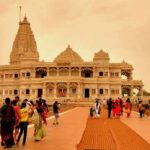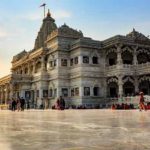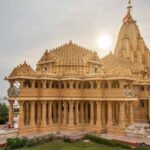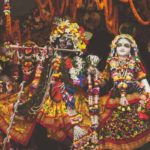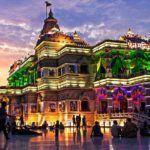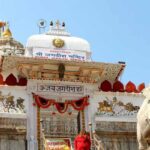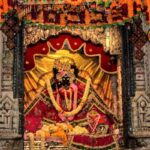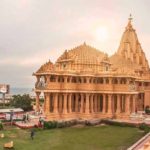Dwarkadhish Temple Mathura, located in Mathura, India, is a revered Hindu shrine that holds profound religious and cultural significance. This temple is dedicated to Lord Krishna, who is affectionately referred to as Dwarkadhish, meaning “Lord of Dwarka.” The temple’s architecture and history are a testament to the devotion and adoration of Lord Krishna’s followers.
Constructed in the 19th century, the Dwarkadhish Temple showcases exquisite North Indian architectural styles. Its intricate carvings, ornate spires, and beautifully crafted sculptures reflect the artistic prowess of the era. The temple complex consists of multiple halls, courtyards, and shrines that narrate the life and legends of Lord Krishna through intricate artwork and sculptures.
Devotees from all over the world visit the Dwarkadhish Temple to seek blessings, immerse themselves in spiritual practices, and experience a sense of divine connection. The temple’s atmosphere is filled with the sounds of devotional chants, bells, and the aroma of incense, creating an aura of sanctity and reverence.
The main deity, Lord Krishna, is depicted in the temple’s inner sanctum adorned with rich attire and ornaments. The idol’s captivating presence evokes a sense of awe and devotion among the worshippers. The temple hosts various religious rituals, pujas, and festivals throughout the year, with Janmashtami, Lord Krishna’s birthday, being a grand celebration that attracts numerous pilgrims.
The Dwarkadhish Temple not only serves as a religious site but also as a cultural hub. It acts as a repository of the region’s history, legends, and beliefs. The temple’s architecture and artistry provide a glimpse into the opulence and devotion that characterized the era in which it was built.
In conclusion, the Dwarkadhish Temple Mathura stands as a magnificent tribute to the beloved deity Lord Krishna. Its architectural grandeur, spiritual significance, and cultural heritage make it a focal point of devotion and a symbol of India’s rich religious tapestry. The temple continues to draw countless pilgrims and visitors who seek solace, inspiration, and a connection to the divine Religious Places in Rajasthan.
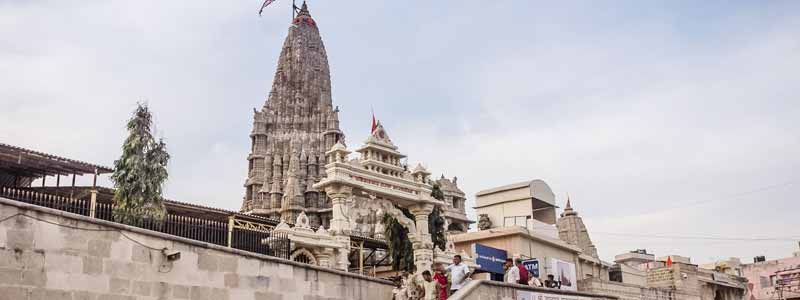
Dwarkadhish Temple- Darshan & Aarti Timings
| Summer | |
| Morning | Evening |
| Mangla 6:30 am to 7:00 am | Utthapan 4:00 pm to 4:20 pm |
| Shringar 7:40 am to 7:55 am | Bhog 4:45 am to 5:05 pm |
| Gwal 8:25 am to 8:45 am | Aarti 5:20 pm to 5:40 pm |
| Rajbhog 10:00 am to 10:30 am | Sayan 6:30 pm to 7:00 pm |
| Winter | |
| Morning | Evening |
| Mangla 6:30 am to 7:00 am | Utthapan 3:30 pm to 3:50 pm |
| Shringar 7:40 am to 7:55 am | Bhog 4:20 pm to 4:40 pm |
| Gwal 8:25 am to 8:40 am | Aarti 6:00 pm |
| Rajbhog 10:00 am to 10:30 am | |

History of Dwarkadhish temple, Mathura
The history of the Dwarkadhish Temple in Mathura is intertwined with the deep-rooted devotion and reverence for Lord Krishna, a central figure in Hinduism. While the temple itself was built in the 19th century, its origin lies in the ancient city of Mathura, which holds immense significance in the life and legends of Lord Krishna Rajasthan Pilgrimage Tour.
Mathura, believed to be the birthplace of Lord Krishna, has been a pilgrimage site for thousands of years. The city’s association with Krishna’s early life and his divine acts has led to the establishment of various temples and shrines dedicated to him. The concept of worshiping Krishna as the Lord of Dwarka (Dwarkadhish) emerged from his legendary role as a king in the city of Dwarka.
The concept of Dwarkadhish, or Lord of Dwarka, is based on Krishna’s role as the ruler of the prosperous city of Dwarka, described in various Hindu texts and epics. According to these narratives, Lord Krishna shifted his capital to Dwarka, where he reigned as a just and benevolent king. This aspect of Krishna’s life became a significant focus of devotion, leading to the creation of temples that portray him in this majestic role.
The modern Dwarkadhish Temple in Mathura was built in the 19th century by the efforts of Seth Gokul Das Parikh, a devout merchant, and his family. The temple’s construction was completed in 1814, and it stands as a remarkable example of North Indian architecture of that era. The temple’s design and artwork vividly depict Lord Krishna’s life, his royal presence in Dwarka, and his divine exploits.
The temple’s architecture is a blend of Rajasthani and Mughal styles, with its spires, domes, and intricately carved facades reflecting the artistic finesse of the time. The inner sanctum houses the idol of Dwarkadhish (Lord Krishna) along with idols of his beloved consort Radha and other deities.
Over the years, the Dwarkadhish Temple has undergone renovations and restorations to preserve its beauty and sanctity. It continues to attract devotees, pilgrims, and tourists from all around the world who come to seek blessings, immerse themselves in Krishna’s divine aura, and witness the rich cultural heritage associated with the temple.
In summary, the Dwarkadhish Temple Mathura is a testament to the enduring devotion and cultural significance of Lord Krishna. Its history is rooted in the ancient stories of Krishna’s royal role in Dwarka, and the temple itself stands as a remarkable architectural and spiritual monument that honors his divine presence.
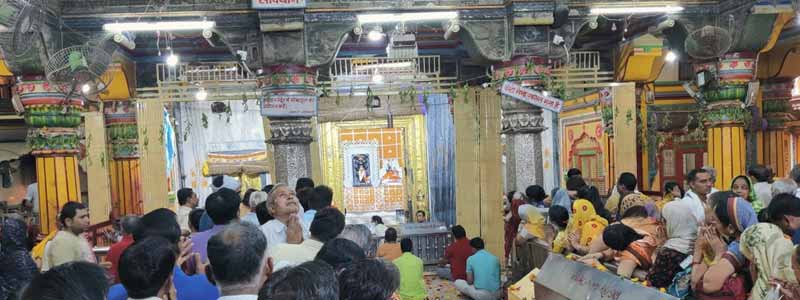
Architecture of Dwarkadhish temple, Mathura
The architecture of the Dwarkadhish Temple in Mathura is a captivating blend of North Indian architectural styles, reflecting the artistic brilliance of the 19th century. This temple, dedicated to Lord Krishna as the Dwarkadhish (Lord of Dwarka), boasts a captivating design that embodies both religious symbolism and aesthetic grandeur.
The temple’s façade showcases a harmonious amalgamation of Rajasthani and Mughal architectural elements. Its most distinctive feature is the ornate entrance, adorned with intricately carved panels that depict scenes from Hindu mythology, particularly Lord Krishna’s life and exploits. The intricate carvings continue throughout the exterior, illustrating the temple’s devotion to storytelling through art.
The temple’s towering spires, known as shikharas, are a striking feature that draws the eye. These shikharas exhibit the iconic fluted design often associated with North Indian temples. They culminate in a graceful conical pinnacle adorned with sculptural finials, creating an imposing yet elegant silhouette against the sky Dwarkadhish Temple Mathura.
As visitors step inside, they are greeted by a series of courtyards and halls, each featuring more sculptural representations of Krishna’s life. The main sanctum, or garbhagriha, houses the central deity, Lord Dwarkadhish, in a resplendent form. The idol is often depicted adorned in royal attire, reflecting Krishna’s role as the king of Dwarka. The sanctum is usually dimly lit, creating an atmosphere of reverence and devotion.
The temple’s inner sanctum is adorned with rich ornamentation and sculptures that narrate Krishna’s stories, his interactions with devotees, and his divine persona. The intricate detailing on the walls, pillars, and ceilings attests to the skill and dedication of the craftsmen who worked on the temple.
Overall, the Dwarkadhish Temple’s architecture exudes a sense of opulence and devotion. Its intricate carvings, elaborate spires, and captivating sculptures transport visitors into a realm of spiritual and artistic richness. The temple stands as a testament to the profound influence of Lord Krishna’s legacy on both religious and architectural realms, offering a space for worship, contemplation, and aesthetic appreciation.
Best time to visit Dwarkadhish Temple Mathura
The Dwarkadhish Temple in Mathura is a significant pilgrimage site and a place of religious devotion. The best time to visit the Dwarkadhish Temple largely depends on weather conditions, crowd levels, and the festivals associated with Lord Krishna. Here are the recommended times to plan your visit:
Winter (October to February): This is generally considered the best time to visit the Dwarkadhish Temple. The weather during these months is cool and pleasant, making it comfortable for exploring the temple complex and the city of Mathura. The winter season also coincides with several important festivals like Diwali and Janmashtami (Lord Krishna’s birthday), during which the temple sees a surge in pilgrims and devotees.
Spring (March to April): Spring is another good time to visit as the weather is moderate and favorable for outdoor activities. The Holi festival, which celebrates the colors of spring and the love of Radha-Krishna, is a major event in Mathura. It’s a vibrant and joyful time to be in the city and witness the festive spirit.
Monsoon (July to September): Monsoon can be a challenging time to visit due to heavy rains and potential waterlogging in some areas. However, the temple and the city can appear even more serene and lush during this time. If you don’t mind the rain and are seeking a quieter experience, you might consider visiting during the monsoon.
Summer (May to June): Summers in Mathura can be quite hot, with temperatures soaring. It’s advisable to avoid visiting during these months, as the extreme heat can make outdoor activities uncomfortable.
Remember that major festivals and events can significantly increase the number of visitors, so plan your trip accordingly if you wish to witness these celebrations. Also, check for any local holidays or important religious dates that might affect the temple’s accessibility.
In summary, the best time to visit the Dwarkadhish Temple Mathura is during the winter months (October to February) when the weather is pleasant and several significant festivals take place. Spring is also a good option, while the monsoon and summer months should be approached with caution due to weather conditions.
How to Reach Dwarkadhish temple, Mathura
Reaching the Dwarkadhish Temple Mathura is relatively easy, given its significance as a prominent pilgrimage site. Mathura is well-connected by various modes of transportation. Here’s how you can reach the Dwarkadhish Temple:
By Air: The nearest major airport to Mathura is the Indira Gandhi International Airport in New Delhi, which is about 160 kilometers away. From the airport, you can hire a taxi or take a train to Mathura. Alternatively, there are domestic airports in Agra and Lucknow, both of which are connected to major Indian cities.
By Train: Mathura Junction is a major railway station well-connected to various cities across India. It’s on the Delhi-Mumbai and Delhi-Chennai railway routes. Trains like the Rajdhani Express and Shatabdi Express also have stops at Mathura. Once you arrive at the railway station, you can hire a local taxi, auto-rickshaw, or cycle-rickshaw to reach the Dwarkadhish Temple, which is located in the heart of the city.
By Road: Mathura is well-connected by road to major cities in North India. National Highway 44 (NH 44) passes through Mathura, making it accessible by car or bus. You can take a private car, hire a taxi, or use intercity buses to reach Mathura. The city is about a three-hour drive from New Delhi.
By Bus: Mathura has a well-developed network of state-run and private buses that connect it to nearby cities and towns. You can find buses from major nearby cities like Agra, Delhi, Jaipur, and Lucknow. The bus station is generally located near the railway station.
Local Transportation: Once you’re in Mathura, you can use auto-rickshaws, cycle-rickshaws, or taxis to get around the city and reach the Dwarkadhish Temple. The temple is located in the heart of Mathura, and most local transportation options can drop you off nearby.
Remember to check for the latest transportation options and schedules, especially if you’re planning to visit during peak seasons or festivals. Overall, reaching the Dwarkadhish Temple Mathura is convenient and accessible through various modes of transportation.

